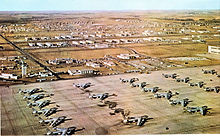
The 2d Bomb Wing is a United States Air Force unit assigned to the Air Force Global Strike Command and the Eighth Air Force. It is stationed at Barksdale Air Force Base, Louisiana. The wing is also the host unit at Barksdale. The wing was assigned to the Air Force Global Strike Command in February 2010 as part of the reassignment of Eighth Air Force.

The 17th Training Wing is a United States Air Force unit assigned to the Air Education and Training Command Second Air Force. It is stationed at Goodfellow Air Force Base, Texas. The wing is also the host unit at Goodfellow. It was activated as a non-flying wing on 1 July 1993. Its mission is to train intelligence personnel in all the branches of the armed forces, as well as firefighters and a few other specialties. The wing trains Air Force enlisted intelligence, cryptology and linguist AFSCs 1N0, 1N1, 1N2, 1N3, 1N4, 1N5, 1A8, Air Force intelligence officer AFSC 14N, and military firefighters from all branches. Many corresponding Army, Navy, Space Force, and Marine Corps intelligence personnel are also trained at Goodfellow AFB, and assigned to the local units.

The 7th Bomb Wing is a United States Air Force unit assigned to the Global Strike Command Eighth Air Force. It is stationed at Dyess Air Force Base, Texas, where it is also the host unit.

The 499th Air Refueling Wing is an inactive United States Air Force (USAF) unit that was last active at Westover AFB, Massachusetts in June 1966.

The 320th Air Expeditionary Wing is a provisional United States Air Force unit assigned to the Air Force District of Washington. It is stationed at Bolling AFB, District of Columbia. The 320 AEW may be activated or inactivated at any time.
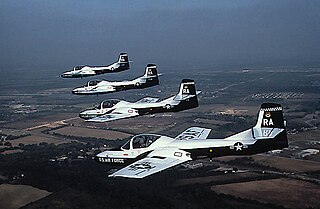
The 340th Flying Training Group is a reserve component of the United States Air Force. It is assigned to the Twenty-Second Air Force of Air Force Reserve Command, at Randolph Air Force Base, Joint Base San Antonio, Texas. The group is the headquarters for reserve flying training squadrons that are associate squadrons of Air Education and Training Command flying training squadrons.
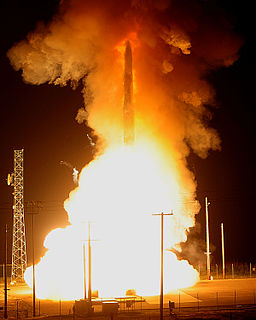
The 576th Flight Test Squadron is a United States Air Force unit assigned to Air Force Global Strike Command. The 576th is stationed at Vandenberg Space Force Base, California. The unit was first established in January 1943 as the 576th Bombardment Squadron. After training with Consolidated B-24 Liberators in the United States, the squadron deployed to the European Theater of Operations, where it participated in the strategic bombing campaign against Germany. The squadron was awarded a Distinguished Unit Citation for its actions in an attack on Gotha, Germany in February 1944. Following V-E Day, the squadron returned to the United States and was inactivated. It was again active between September 1947 and November 1949 in the reserve, but does not appear to have been fully manned or equipped with tactical aircraft at this time.

The 319th Missile Squadron is a United States Air Force unit assigned to the 90th Operations Group at Francis E. Warren Air Force Base, Wyoming. The squadron is equipped with the LGM-30G Minuteman III intercontinental ballistic missile, with a mission of nuclear deterrence. It is the flagship squadron of the 90th Missile Wing.

The 321st Missile Squadron is a United States Air Force unit. It is assigned to the 90th Operations Group, stationed at Francis E. Warren Air Force Base, Wyoming. The squadron is equipped with the LGM-30G Minuteman III Intercontinental ballistic missile (ICBM). Their mission is to operate safe and secure nuclear weapons, maintain mission ready facilities, and on order destroy OPLAN assigned targets.

The 401st Air Expeditionary Group is a provisional United States Air Force unit assigned to United States Air Forces in Europe to be activated or inactivated at any time as needed. It is stationed at Ramstein Air Base, Germany.

The 98th Operations Group is a component unit of the Nevada Test and Training Range, assigned to the United States Air Force Air Combat Command. The group is stationed at Nellis Air Force Base, Nevada. It provides day-to-day control of the Nevada Test and Training Range (NTTR) and directly supports Air Force, joint and multi-national test and training activities; and operates two Air Combat Command bombing ranges; the NTTR and Leach Lake Tactics Range, near Barstow, California.

The 308th Armament Systems Group is a unit of the United States Air Force's 308th Armament Systems Wing, stationed at Eglin Air Force Base, Florida. The group was first activated at Gowen Field, Idaho as the 308th Bombardment Group. It served as a Consolidated B-24 Liberator unit in the China-Burma-India Theater, where it conducted long range bombing missions against Japanese forces, earning a Distinguished Unit Citation. Following V-J Day, it returned to the United States and was inactivated in January 1946.

The 830th Bombardment Squadron is an inactive United States Air Force unit. Its last assignment was with 509th Bombardment Wing at Pease Air Force Base, New Hampshire. It was active during World War II in the Mediterranean Theater of Operations as a Consolidated B-24 Liberator unit, where it participated in the strategic bombing campaign against Germany. It earned a Distinguished Unit Citation. Following V-E Day, the squadron returned to the United States and began training with the Boeing B-29 Superfortress at Smoky Hill Army Air Field, Kansas. When its parent group inactivated in 1946, it moved to Roswell Army Air Field, New Mexico, where it joined the United States' first nuclear capable unit, the 509th Composite Group. The squadron remained part of the 509th until it was inactivated when the wing converted to the Boeing B-52 Stratofortress.

The 51st Bombardment Squadron is an inactive United States Air Force unit. It was last assigned to the 68th Bombardment Wing at Seymour Johnson Air Force Base, North Carolina, where it was inactivated on 30 September 1982.

The 77th Weapons Squadron is a United States Air Force unit assigned to the USAF Weapons School, stationed at Dyess Air Force Base, Texas. The 77th is a Geographically Separated Unit of the 57th Wing, stationed at Nellis Air Force Base, Nevada. The mission of the squadron is to provide B-1 Lancer instructional flying.

The 68th Air Refueling Squadron is an inactive United States Air Force unit. It was last assigned to the 305th Bombardment Wing at Bunker Hill Air Force Base, Indiana, where it was inactivated on 25 March 1965.
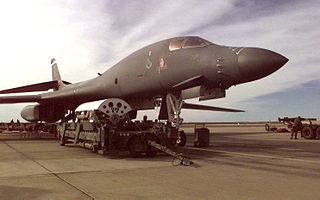
The 345th Bomb Squadron is a United States Air Force Reserve squadron, assigned to the 489th Bomb Group. It is stationed at Dyess Air Force Base, Texas, where it is an associate unit of the 7th Bomb Wing.
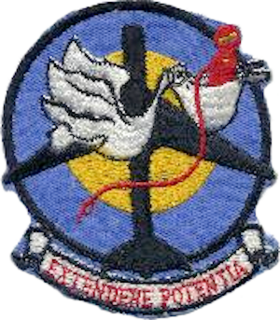
The 308th Air Refueling Squadron is an inactive United States Air Force unit. It was last assigned to the 2d Bombardment Wing at Hunter AFB, Georgia. It was inactivated on 1 March 1960.

The 907th Air Refueling Squadron is an inactive United States Air Force unit. It was last assigned to the 91st Bombardment Wing at Glasgow AFB, Montana, where it was inactivated on 25 June 1968. From 1963 to 1968 the squadron served as the air refueling element of its parent wing.

Bangor Air National Guard Base is a United States Air National Guard base. Created in 1927 as the commercial Godfrey Field, the airfield was taken over by the U.S. Army just before World War II and renamed Godfrey Army Airfield and later Dow Army Airfield. It became Dow Air Force Base in 1947, when the newly formed U.S. Air Force took over many Army air assets. In 1968, the base was sold to the city of Bangor, Maine, to become Bangor International Airport but has since continued to host Maine Air National Guard units under a lease agreement with the city.





